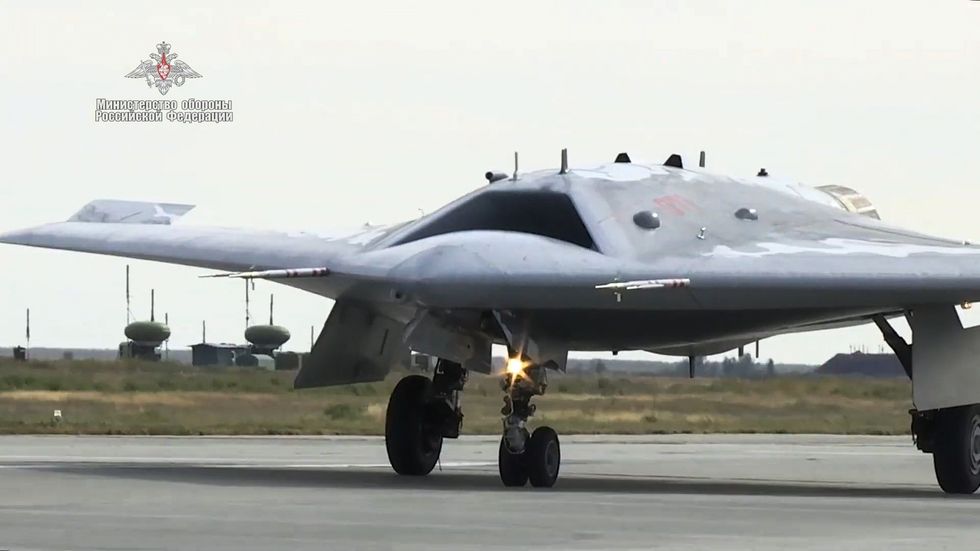
Okhotnik flying alongside the Sukhoi Su-57 Felon fighter.
Russia is pushing its new unmanned combat aerial vehicle out the door and into the hands of the military sooner than expected. The S-70 Okhotnik (“Hunter”) drone will enter service with the Russian Aerospace Force a year earlier than planned, in 2024. That means Hunter could become the first high-performance combat drone designed for large-scale conventional warfare to enter service with any country.
Russian media first spotted the drone in January 2019 as it was performing tests at the Novosibirsk-based Chkalov Aviation Plant. The aircraft resembles a boomerang with a large air intake in the front on the top half of the aircraft, and a shrouded engine nozzle. The famous Sukhoi Design Bureau, makers of Cold War jets and today’s Su-35 Flanker-E and Su-57 Felon fighters, designed the drone.
Tipping the scales at 20 tons, Okhotnik is about as heavy as a two-engine American F-15 Eagle fighter. The drone is designed to carry up to 13,200 pounds of munitions, including air-to-air and air-to-ground missiles, in an internal weapons bay. The drone will have a range of 3,240 nautical miles and a top speed of 620 miles an hour.
Okhotnik was originally described as an autonomous drone capable of carrying out missions in support of crewed aircraft. American efforts to develop a “loyal wingman” that can operate alongside crewed fighters led to reports that Okhotnik would follow the same path. Okhotnik can reportedly execute strike missions against important enemy targets, including air defense systems, headquarters units, and others
Russia has been trying to catch up to the West in the field of autonomous weapon systems, in one case rushing the Uran-9 unmanned ground vehicle drone into combat in Syria. Uran-9 performed badly in real-world operational conditions, though the Russians did learn important lessons.
The U.S., as Forbes points out, has been using armed drones since the attacks on September 11, 2001, but has proceeded haltingly in developing large, heavily armed drones like Okhotnik. Although the U.S. MQ-9 Reaper drone has been in service since the 2010s, it’s optimized for use in low-intensity conflict and against insurgencies. Against modern air defenses fielded by modern armies, Reaper would probably be shot down in droves.
The Air Force is currently proceeding with its own “loyal wingman” semi-disposable drones, and the Navy is pursuing the MQ-25A Stingray carrier-based unmanned tanker.
Uninhabited aerial vehicles (UAVs)
The Russian armed forces have maintained their focus on deriving greater capability from UAVs. The Iskander missile brigades are reported to now maintain subordinate organic UAV formations, equipped with quadcopters for force-protection tasks and Orlan-10s for target-acquisition and battle-damage assessment.
The armed forces continue to integrate the lessons of operations in Syria. In 2019, Russian analysts said that there was emphasis on improving interoperability between artillery and UAVs, and between UAVs and fixed-wing and rotary-wing aviation. One aspiration was to further reduce the time between target acquisition and engagement. Orlan and Forpost UAV teams, analysts understand, now have as standard tasks not only target acquisition but also battle-damage assessment and adjusting artillery fire. At the same time, the Syria mission has also led to greater focus on countering adversary use of UAVs.
Meanwhile, there was further development of the Aerospace Forces’ first large uninhabited combat air vehicle in 2019, with the first flight of the 20-tonne S-70 Okhotnik. A modernised six-tonne Altius UAV also took to the air, with this variant fitted with a satellite communications link. Precision-guided weapons for these systems are in test. It was reported that the Tsentr-2019 exercise involved UAVs working as independent `strike groups’, with targets including headquarters and command posts, air-defence systems, transport infrastructure and enemy reserves’ avenues of approach, though it was not reported that UAV systems were armed during these experiments. An additional order has been announced for Forpost-M UAVs, improved in light of the Syria experience, though due to the import-substitution programme it has been specified that this can contain only Russian components.
How Good Is Russia’s New Sukhoi S-70 Okhotnik-B “Hunter” Stealth Drone?
Watch Russia’s S-70 Unmanned Combat Air Vehicle Fly With An Su-57 For The First Time
New “Hunter-B” Drone to Provide Armed, Remotely-Piloted Capability.